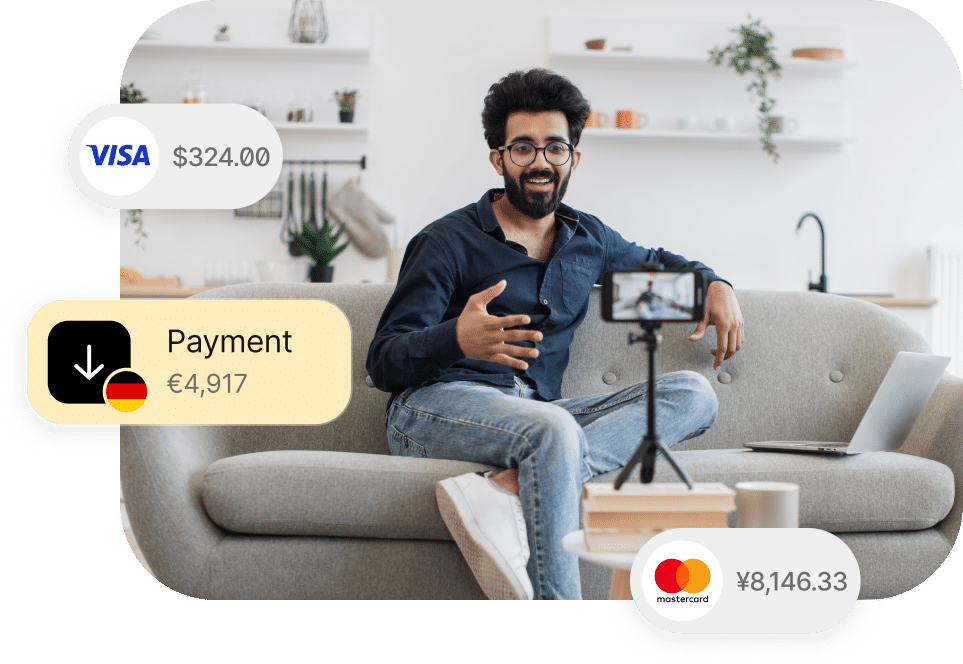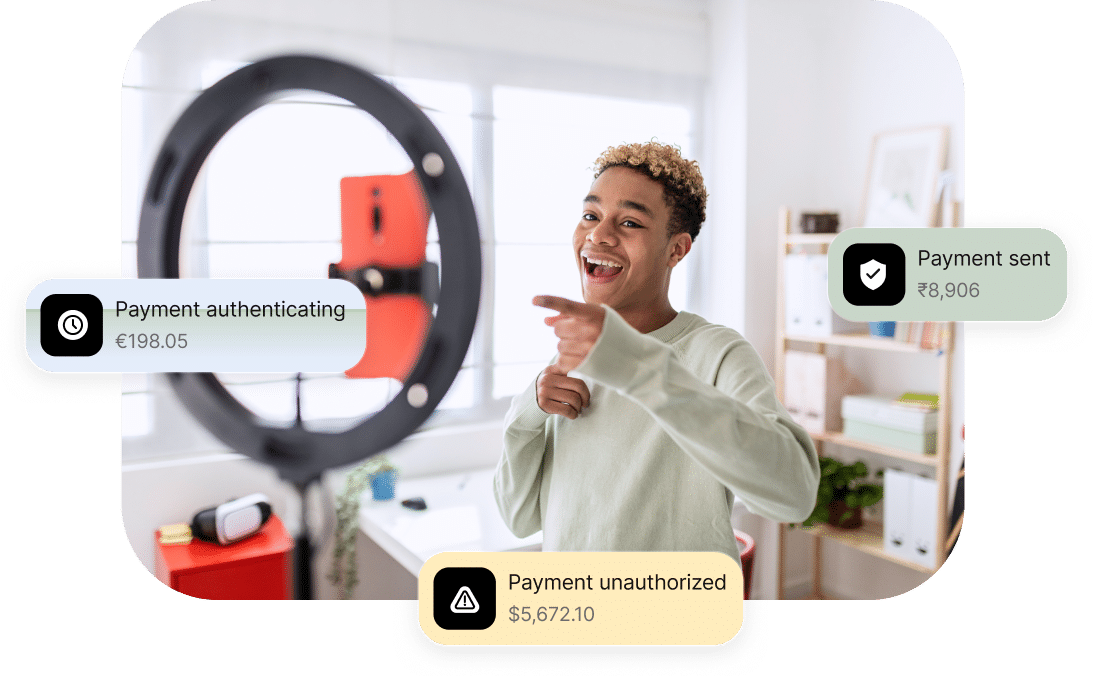Your Ultimate Influencer Payment Platform
Building a powerful affiliate network depends on making your payees happy. Our automated payment workflows make the process simple and efficient so you save time, avoid errors, and delight your affiliates.
Affiliate and Influencer Features
Lighting-Fast Mass Payments at Scale
Our instant payment processing and automated reconciliation deliver unmatched speed and reliability to build trust and satisfaction.

Pay Anyone, Anywhere
Scale anywhere with cross-border payments to 200+ countries and territories in 120 currencies via 50+ payment methods and built-in multi-entity and multi-language capabilities.
Personalized Onboarding
A fully customizable, self-service onboarding system designed to provide a user-friendly experience.


Reduce Payment Risks
Built-in OFAC screening, enterprise-grade security, and advanced fraud controls ensure every payment is checked for legitimacy and legality.
Integrate With Critical Systems
Connect with platforms like Everflow, Phonexa, and Swaarm to manage affiliate and influencer payments. Synchronize detailed transaction reports with your ERP system to increase visibility.


Automated Tax Compliance
Digitally collect and validate W-9 and W-8 series tax forms, or VAT and local tax IDs during onboarding, and have submission-ready 1099 and 1042-S reports to eFile during tax season.
Customer Stories
Don’t just take our word for it,
see what our customers are saying
How It Works
Up and running in weeks, not months
Collaborative customer support with customized onboarding to get you operational quickly
Step 1
Plan
Kickstart your success with a comprehensive initial call to align on goals, scoping, and technical configurations for your setup and to prepare you for training.
Step 2
Configure
Customer onboarding experts configure Tipalti sandbox and production environments, test the hosted payee portal or embedded iFrame, execute sample payment runs, and establish integrations.
Step 3
Deploy
In-depth training on the Tipalti Hub and end-to-end payment automation functionalities will ensure thorough knowledge transfer to turbocharge your successful launch.
Step 4
Adopt
Tipalti supports user adoption and change management during launch with the option to guide payees through onboarding too. Once set, you’ll be ready to fund your Tipalti Virtual Account, execute your first batch of payments, and officially launch Tipalti.
Step 5
Optimize
Following your setup, technical support teams are always available by phone and email, and the Tipalti customer success team will continuously advise you on achieving your goals.
Products
One Solution for All Your Global Finance Operations
Tipalti’s AI-driven finance automation solution simplifies global accounts payable, procurement, expenses, and mass payments so mid-sized companies can scale efficiently.

Ready to save time and money?
Book a demo to get started today and take control of your finance operations with Tipalti.
Recommendations
You may also like
Affiliates Payment Solutions FAQs
How do you define affiliates, and are they different from influencers and creators?
Although the terms are often used interchangeably, affiliates, influencers, and creators have distinct roles in the digital marketing ecosystem.
Affiliates
Individuals or entities that promote products or services while earning a commission for every sale, lead, or specific action generated through promotional efforts. Key features include:
- Tracking: they use unique affiliate links or codes to track referrals.
- Performance-based: affiliates earn money based on the results they drive, like sales, clicks, and sign-ups.
- Partnerships: they typically partner with brands through affiliate programs or networks.
- Focused on content: promotion methods include blogs, social media, websites, email marketing, and more.
One example of an affiliate partnership is a blogger who reviews products, posts about them on social channels, and includes affiliate links.
Influencers
Influencers are typically individuals who have established credibility and a significant following on social media channels. They influence an audience’s opinions and behaviors based on their expertise, authority, or relationship with followers. Key features of influencer programs include:
- Reach: influencers reach a large and specific audience, often within a particular niche (like fashion, fitness, or beauty).
- Engagement: these marketers tend to have a higher level of engagement with followers.
- Content creation: they create content that resonates with an audience. This can include media like videos, photos, stories, and posts.
- Paid collaborations: influencers often work with brands on sponsored content, endorsements, and partnerships.
One example of an influencer is an Insta model that promotes branded beauty products through sponsored posts. Another example is product seeding, where brands send free items to influencers in exchange for exposure.
Creators
These are individuals who create original content. This can involve media like music, videos, art, blogs, and more. While some influencers are also creators, the term “creator” emphasizes content production over the influence on an audience. Key characteristics include:
- Producing content: a creator primarily focuses on generating high-quality, original content.
- Creativity: a creator’s value lies in creativity, skills, and the ability to produce valuable and engaging content. Creator payments are based on media produced.
- Platforms: they use include TikTok, YouTube, blogs, and Patreon.
- Monetization: creators often monetize their content through ads, subscriptions, sponsorships, and sales of their products or services.
One prime example of a creator is the famous YouTuber Mr. Beast, who became famous by creating videos in which he gifted millions of dollars to participants.
Critical Differences Between Affiliates, Influencers, and Creators
- Affiliates vs. Creators: Affiliates might not create original content, as their main goal is to drive sales. Creators focus on production, with monetization as a by-product.
- Influencers vs. Affiliates: While influencers focus on building relationships and influencing opinions, affiliates concentrate on driving sales through tracked links.
Creators vs. Influencers: all influencers are creators, but not all content creators are influencers. Influencers will have a significant following and influence, while creators may focus on content production without needing an audience.
What are influencer payments?
Influencer payments are compensation for promoting a brand’s products or services. Many influencers (even micro-influencers) no longer accept free products in exchange for money. Thus, a different form of payment solution is in order.
How you pay influencers will vary depending on factors like reach, niche audience, engagement rate, and other types of collaboration.
A few different types of influencer partnerships and payments include:
Pay Per Post
A payment is made for each piece of content created by the influencer. This pricing structure is typically used for one post and can cost thousands of dollars depending on the popularity of the influencer.
Long-Term Contracts
These are agreements where influencers receive regular payments over a set period in exchange for ongoing promotion. This is the best pricing structure for brands looking to build a long-term relationship over simply gifting an influencer.
Flat Fee
This is a fixed payment of a predetermined amount paid to an influencer for their promotional services.
Pay-Per-Click (PPC)
In this structure, influencers are paid based on the number of clicks generated from their content. This is suitable for campaigns aimed at driving traffic.
Pay-Per-Engagement (PPE)
In this scenario, payment is based on the level of engagement (for example, likes, comments, shares) generated by the influencer’s content. This is most effective for increasing brand awareness and audience interaction.
Pay-Per-View (PPV)
These are influencer payments based on the number of views a piece of content receives. This works best on video platforms like TikTok, Instagram, and YouTube.
Commission-Based
This is how the bulk of affiliates are paid. This payment represents a percentage of sales generated through the influencer’s unique affiliate link or code.
What is an affiliate to your company?
An affiliate is an independent partner who promotes the products or services of a brand in exchange for a commission. In affiliate marketing, unique tracking links or codes are used to ensure that referrals are correctly attributed to them.
This business relationship is performance-based, meaning an affiliate’s earnings depend on the outcome of their campaigns. Common characteristics of an affiliate include:
- Unique tracking methods to monitor traffic and sales
- Earns commission for specific actions (clicks, likes, etc.)
- Uses various marketing channels (websites, blogs, social media)
- Payments made regularly ((via Automated Clearing House (ACH), wire, etc.)
Companies will often run affiliate programs or join affiliate networks to better manage relationships with affiliates. These programs typically provide affiliates with marketing materials, tracking tools, and support.
What is an influencer payment platform?
An influencer payment platform is a digital tool designed to manage and streamline payments between brands and influencers. Time and again, case studies show that automation ensures faster payments, increases accuracy, and strengthens business relationships.
The top features of an influencer payment platform include:
Automated Payments
Automation ensures payments are received on time based on predefined payment schedules. Systems should support multiple payment methods, including PayPal, bank transfers, direct deposit, etc.
Contract and Agreement Handling
Influencer payment solutions help streamline the creation and signing of digital contracts and agreements, ensuring that all legal and compliance requirements are met.
Self-Service Supplier Portal
Paying influencers is easy when you provide them with a self-service portal. Here, they can upload essential contact data and tax information, check on payment status, and submit new invoices. This eliminates the need for the accounts payable team to answer multiple payment inquiries or input influencer data manually.
Campaign Management
Some systems allow a business to monitor campaign performance, tracking metrics like engagement, impressions, clicks, and conversions. It will also keep track of content deliverables and agreed-upon milestones.
Global Payments
Successful influencer marketing campaigns typically reach a global audience. This means an organization may need to pay international influencers. Look for a payment solution that automates currency exchange and facilitates global tax compliance. These systems typically automate tax form collection and foreign exchange (FX) tasks.
Additional Features
- Provides real-time data on campaign performance and ROI metrics
- Offers access to a database of influencers across many niches and platforms
- Provides tools for seamless collaboration between influencers and brands
- Ensures all financial transactions are secure and protected against fraud
- Verifies authenticity of influencers and their engagement metrics
How do you calculate affiliate payments?
Specific terms of the affiliate program determine how you calculate affiliate payments. Here are a few methods typically used:
1. Define the Payment Structure
A standard method is where affiliates earn a percentage of the sale (commission). Payments can also be made based on a flat rate, salary, pay-per-click, etc.
2. Track Affiliate Performance
Use unique tracking links and codes to better gauge the success of your affiliate programs. Affiliates will also use specific discount codes that customers enter at checkout.
3. Verify Transactions
Ensure all referred sales are legitimate and not subject to fraud or returns. Verify the leads meet the criteria set in the affiliate contract.
4. Apply Commission Terms
Calculate gross sales and multiply that by the agreed-upon commission rate. Deduct any refunds or chargebacks from the total sales before applying the commission.
5. Consider Bonuses and Rewards
Consider adding in other bonuses and rewards for affiliates who exceed sales thresholds. Higher commission rates make sense for affiliates with higher sales volumes and ecommerce transactions.
